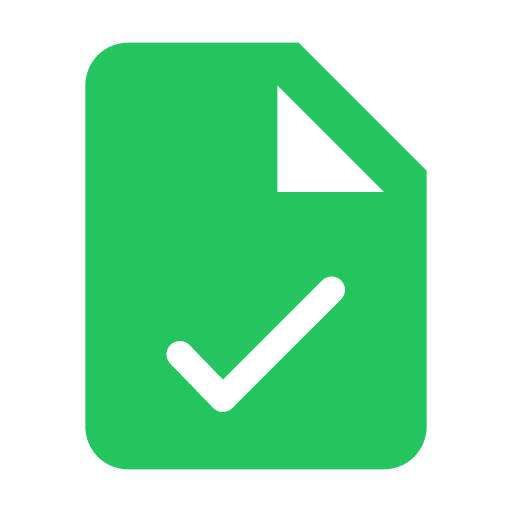
How to: Tax return

.png?alt=media&token=014e6042-0dfe-46c9-9498-0f8424f5261e)
Introduction
Today you are helping a person to prepare a tax return.

Mina
📝 Task
The tax return: what you should know
The tax return is a document that taxpayers in the United States use to report their income, deductions and tax credits to the Internal Revenue Service, and in many cases also to their state tax authority. It is used to determine the actual tax liability for the year and to ensure that the correct amount of tax has been paid. Many people receive a refund if too much tax was withheld from their paychecks, while others may have to make an additional payment if not enough was paid during the year. Filing a tax return is required for most individuals, especially those whose income exceeds a certain threshold, but even those with lower incomes may benefit from filing voluntarily in order to claim refundable tax credits such as the Earned Income Tax Credit or the Child Tax Credit.
Employees usually have income tax automatically withheld from their salary by their employer throughout the year. However, since not all individual circumstances can be considered in advance, the annual tax return is the way to adjust for any differences. This means that overpaid taxes can be refunded, or underpayments can be settled.
Whether a tax return must be filed depends on several factors, including income level, filing status and age. Filing status categories in the US include single, married filing jointly, married filing separately, head of household and qualifying widow or widower. These categories affect the standard deduction and tax rates applied. People who are self-employed, have multiple sources of income or have sold investments are also generally required to file a return.
Many expenses and payments can be deducted or credited to reduce the overall tax burden. These include certain job-related costs, student loan interest, charitable donations, medical expenses, contributions to retirement accounts and education-related costs. Unlike in some other countries, the US tax system offers a wide range of tax credits and deductions that can significantly influence the final amount owed or refunded.
To make the process easier and to avoid mistakes, many taxpayers use tax preparation software or consult a tax advisor. The regular deadline for submitting the federal tax return is April 15 of the following year. Those who need more time can apply for an extension, which moves the filing deadline to October 15, although any taxes owed are still due in April. Filing a tax return carefully and on time can be financially beneficial, as many people receive a refund each year.
📝 Determine whether the given statements are true or false.
How do you make a tax return?
To file a tax return in the United States, you start by collecting all necessary documents. This includes income forms such as the W-2 for employees, 1099s for freelance or investment income, and receipts for potential deductions like education costs, donations, or medical expenses. Once everything is gathered, the return can be completed either on paper using IRS forms or more commonly through online tax software or the IRS Free File system.
You begin by entering your personal and income information, followed by any deductions or tax credits, such as retirement contributions, student loan interest, or childcare costs. Self-employed individuals also include business expenses, while investors report gains and losses.
After entering all details, it’s important to review everything carefully. If needed, tax software or a tax advisor can help check for accuracy. Once complete, the return is submitted to the IRS, either electronically or by mail.
A few weeks later, the IRS will send a notice showing whether you’ll receive a refund or need to pay more. If the result seems incorrect, it can be appealed or corrected. Good preparation and documentation help ensure the best outcome from your tax return.
My Daily Life and Expenses
As a software developer, I spend most of my day coding and attending meetings. I've tried to list my expenses, but I'm not sure which of them are tax-deductible.
First of all, there are the daily commuting costs to work that add up quickly. I usually drive, which costs me around $180 per month for gas. Additionally, there are parking fees in the city that amount to about $60 per month. On some days, I take the train when the weather is bad – a monthly pass costs $85.
In my home office, I recently purchased a new height-adjustable desk for $400 and an ergonomic chair for $250. This investment has paid off as my back pain has significantly decreased. There are also smaller expenses for printer paper ($10 per month) and ink cartridges ($30 every two months).
Aside from work, I also invest in my health. My gym membership costs me $50 per month, and recently I bought new sports equipment for $120 to make my workouts more effective. Staying fit is crucial, especially given the many hours I spend in front of the screen.
Then there are the daily expenses for groceries and household items. I spend an average of $350 per month on fresh and healthy products. Occasionally, I treat myself to lunch at a restaurant near my work, which costs about $12 per meal. Since we sometimes combine this with business meetings, I wonder if I can claim a part of these expenses on my taxes.
Once a year, I take a break. This summer, I spent a week in the mountains and rented a cozy cabin for $800. Additionally, I spent $250 on food and $150 on activities like hiking and wellness – an expensive but worthwhile vacation.
Finally, there are the fixed monthly costs like my phone bill ($40) and the internet fees for my apartment ($50). Without a reliable connection, productive work, both in the office and home office, would be nearly impossible.
Now, I need to list all these expenses on my tax return. It's quite challenging to keep track and figure out which costs I might be able to deduct and which ones I can't.
How You Can Deduct Certain Expenses on Your Tax Return
As you already know, many expenses can be claimed as deductions on your tax return, helping to reduce your overall taxable income. Not all costs are fully deductible, and understanding the specifics can help you maximize your tax benefits.
In the United States, deductions generally fall into two categories: above-the-line and below-the-line. Above-the-line deductions reduce your adjusted gross income (AGI), whereas below-the-line deductions reduce taxable income only if they exceed the standard deduction, which was $12,000 for single taxpayers and $24,000 for married couples filing jointly in 2018.
Business expenses are often deductible, including costs related to commuting and maintaining a home office. For instance, commuting costs can be deducted if you itemize expenses. Purchases for your home office, such as a height-adjustable desk or ergonomic chair, can be deducted as business expenses. Small items like printer paper and ink cartridges are also included under this category. The IRS allows deductions for unreimbursed employee expenses, but these need to be ordinary and necessary for your work.
Health-related expenses, such as gym memberships and sports equipment, can sometimes be deducted if they exceed 7.5% of your AGI. Expenses related to maintaining health can be deducted under medical expenses if they are substantial and documented properly.
Travel and meal expenses incurred during business activities are also deductible. If you occasionally treat yourself to lunch at a restaurant during a business meeting, a portion of these costs can be claimed. The IRS generally allows a 50% deduction on business-related meals.
Fixed expenses like your phone bill and internet fees can be deducted proportionally if they are used for work purposes. These costs need to be clearly associated with your business activities to be eligible.
In addition to these, personal deductions like mortgage interest, state and local taxes, and charitable donations are deductible. For example, gifts to qualifying charitable organizations can be deducted up to a certain limit, which can significantly reduce your taxable income.
Tax credits are another valuable tool. They directly reduce the amount of tax owed, rather than just lowering taxable income. Credits like the Earned Income Tax Credit or the Child Tax Credit can provide substantial benefits. The American Opportunity Tax Credit and the Lifetime Learning Credit are available for education expenses, offering up to $2,500 and 20% of the first $10,000 of qualified expenses, respectively.
Understanding these deductions and credits can help you effectively manage your tax return, ensuring that you claim all eligible expenses and maximize your potential refund.
📝 Task
Which of their expenses can the person deduct from tax? Fill in the table.
| Type of costs | Amount of costs | Amount to be deducted | Deductible? (yes/no) | Justification |
|---|---|---|---|---|
📌 Taxes are very complex, but now you understand a lot about them. Fortunately, you can also get help with your tax return.
✅ Example
| Type of costs | Amount of costs | Amount to be deducted | Deductible? (yes/no) | Justification |
|---|---|---|---|---|
| Gas for commuting | $180 per month | - | No | Commuting costs are generally not deductible |
| Parking fees | $60 per month | - | No | Commuting costs are generally not deductible |
| Train pass | $85 per month | - | No | Commuting costs are generally not deductible |
| Height-adjustable desk | $400 | $400 | Yes | Home office expense |
| Ergonomic chair | $250 | $250 | Yes | Home office expense |
| Printer paper | $10 per month | $10 per month | Yes | Home office expense |
| Ink cartridges | $30 every two months | $30 every two months | Yes | Home office expense |
| Gym membership | $50 per month | - | No | Generally not deductible unless part of medical expenses exceeding 7.5% of AGI |
| Sports equipment | $120 | - | No | Generally not deductible unless part of medical expenses exceeding 7.5% of AGI |
| Groceries | $350 per month | - | No | Personal expense |
| Lunch at restaurant (business meeting) | $12 per meal | $6 per meal | Yes | 50% deductible for business-related meals |
| Vacation cabin rental | $800 | - | No | Personal expense |
| Vacation food and activities | $400 | - | No | Personal expense |
| Phone bill | $40 per month | Proportional | Yes | If used for work purposes |
| Internet fees | $50 per month | Proportional | Yes | If used for work purposes |
Objective:
Learners understand the basics of tax returns and work out which income and expenses are relevant for tax purposes. They deal with the tax return process by helping a fictitious person.
Content and methods:
The worksheet guides students step-by-step through the preparation of a tax return using a practical example. They analyze different types of costs, evaluate their deductibility and reflect on the importance of taxes for employees. They deepen their knowledge through interactive tasks and a sample calculation.
Competencies:
- Understanding of the German tax system
- Analysis of tax deductibility and its effects
- Application of economic knowledge to everyday life
- Critical reflection on financial planning
Target group and level:
Year 10 and above

